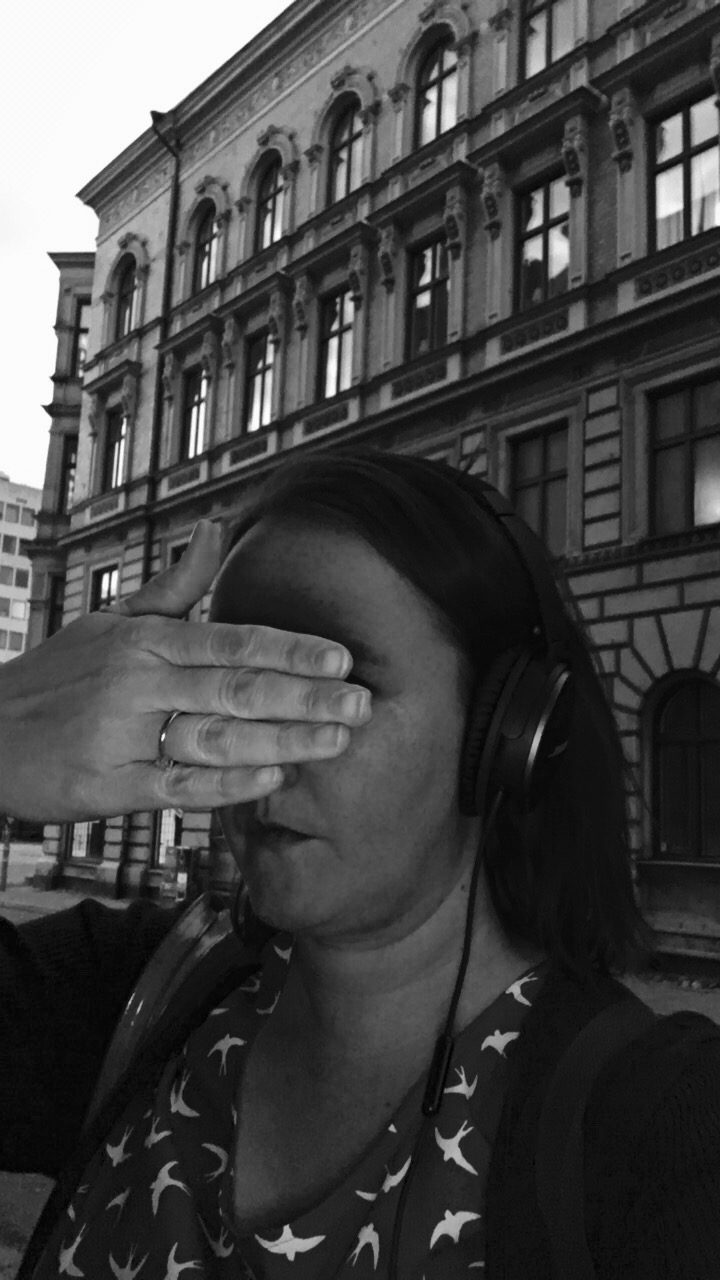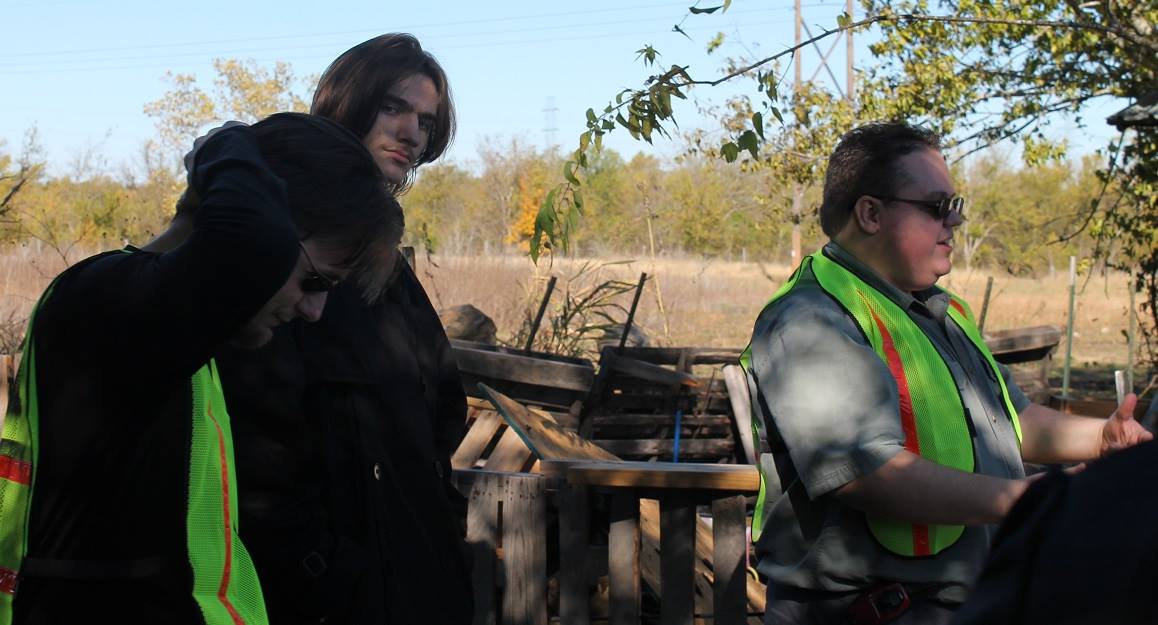I’m going to start off the toolkit series of posts with a really a-typical one, because today I’m writing about a tool that’s so new it doesn’t even have a name. And as is usually the case, talking about this online I was immediately told of an older, successfully play-tested example of almost exactly the same thing! So now we have a category of things. Yea!
Bow-out mechanic: a method used to opt out from a scene without pausing the game, while signalling to the other players that this is the case. Ideally combined with a fiction design where the absence of the character can pass unremarked or always has a natural explanation. (Especially in the latter case, a bow-out mechanic is technically a metatechnique).
Opt In/Opt Out Elements
In Opt In/Opt Out systems, it is common to use methods of active invitation (such as escalation mechanics, warnings about actions, literal gates, quests or other signals that a different experience is about to begin, should you choose to engage with it). Even more common are methods for actively opting out, usually enabling the player to leave situations that have already started – giving the player or the character (or both) ways to pause and/or physically leave a scene they are not comfortable continuing for any reason. A simple example of this is the “cut” rule, where an agreed-upon safe word such as “cut” is used to pause the run-time to check in with players and allow them to leave.
In addition, there are calibration tools, designed for players to check in with each other during play and to align play styles. The simplest of these involve pausing play very briefly for an out-of-character negotiation; others include physical gestures to calibrate play intensity.
This is very important: just a method for pausing play is in itself useless. The participants must also have a culture of being able and willing to use it. When you’re stress checking your system, you should start by thinking about
- physical ability – a hand gesture is useless if your hands are tied; also remember not all participants necessarily have the same amount of hands.
- recollection – will players remember the exit rules in a stressful situation? They need practice!
- social cost/benefit – is it possible to use these tools without loss of face as a player? How do you ensure this?
- coherence of fiction – is it possible for the character to leave a situation without the fiction or the entire game breaking down?
I’ll write about the social aspects many times in the future, but for now let’s just observe that the last two are intimately connected. If I realise, or wrongly believe, that excusing myself would stop or negatively affect the play experience of all my friends, I am much less likely to slip out of a situation that is no good for me as a player.
Also, one of the ways we have hacked the social aspect of opting out is that most cut rules stipulate that the other players are never allowed to question, or ask for, the reason for the cut. I might cut because I’m realising I have urgent diarrhoea, or because the story is veering close to personally traumatic territory I’d rather not tell you about, or because I don’t trust a player who just joined the group. Or even because I’m terribly, terribly, terribly bored. None of these reasons are anybody else’s business. And not asking questions is a great social hack. (You’re allowed, even encouraged to, check in – but ask “are you ok, what can I do?”, not “are you ok, why did you cut?” – your co-player will volunteer whatever she wants).
When Your Character Can’t Opt Out
Sometimes, in some games, it would be useful to have a little more information about this moment. This is especially pertinent to games where the opt-out system is designed for minimal intrusiveness. For instance, you can build into the fiction that every character always has the right and a valid reason to leave any situation, even if a king is speaking to them. But then, how do I as the player of the king know whether that character is going to pray in the grove or feeling that my aggressive play style was a bit too much? How do I as a player signal that my character isn’t necessarily disinterested or overwhelmed or disgusted, and that nothing much should be read into my leaving?
I mean, there are games where many themes or content types are give or take. Let’s say we’re playing a post-apocalyptic story, and torture has not been outright banned as a theme, and it emerges naturally during play. Maybe I don’t think that’s cool, and that leaves me with two choices as a player: either pausing play and suggesting to my group that we play the scene another way, and/or opting out of the scene either as a player, or as as both player and character. (The calibration rules might also allow for negotiating a different simulation level, for instance agreeing that the content is still there, but that we won’t act it out, and instead talk about what happens in the scene and what it means to the characters involved).
But sometimes you can’t opt out of a theme. A few weeks ago in a bar in Oslo, some friends and I were talking about this (because of course we’d talk about larp safety in bars duh). Our example was Brudpris (Bridal Price), a larp by very talented designers Anna-Karin Linder Krauklis and Carolina Dahlberg that I should immediately admit I haven’t played, and neither of its designers were present in the conversation. But people say the game is good! You should read the design notes on nordiclarp.org and check out the web page for this year’s runs, which are sold out.
If you play Brudpris, which is about honour culture in a fictional Nordic 19th century village setting, patriarchal structures, practices and oppression are woven into every element of the game’s design. That’s the point of that larp. And you’re there specifically to experience it, but maybe there are still specific situations where you want to excuse yourself as a player. Now, if you play female, this is actually very difficult to do in a subtle way, because you are so bound by the male characters’ authority.
 We were talking about how to design opportunities to leave into in-game cultures. I had suggested a while earlier that a physical gesture, like hanging your head very demonstratively and walking away, could be useful as a meta-level “I have seen enough at this time” signal, combined with an in-game “I am weary and must go contemplate whatever” signal. You would stay within the aesthetics of the fiction, and maybe even in character, but signal to other players that the thing you were walking away from was not playable for you at this time.
We were talking about how to design opportunities to leave into in-game cultures. I had suggested a while earlier that a physical gesture, like hanging your head very demonstratively and walking away, could be useful as a meta-level “I have seen enough at this time” signal, combined with an in-game “I am weary and must go contemplate whatever” signal. You would stay within the aesthetics of the fiction, and maybe even in character, but signal to other players that the thing you were walking away from was not playable for you at this time.
My friend Trine Lise Lindahl, a kick-ass game designer whose work you should check out (who has also produced a run of Brudpris), said that wouldn’t work at all at Brudpris, because all women hang their head in that culture all the time. She suggested a gesture where you put your hand in front of your eyes. While walking away. Not covering your eyes, just in the air in from of your eyes like a shield, but so you can still see your feet. It’s a gesture that looks pretty natural, especially in a stylised environment, but that no one would actually do day-to-day.
Tested Variants & Physical Nitty-Gritty

Matthew Webb tells me on Facebook his Planetfall larp has this exact mechanic with another gesture. They use, he says, “putting your head down with your hand against the back of the head – mainly because this is a simple gesture that will almost never been done normally.” The source is “an old CIA manual which suggested touching the back of your head seem innocuous but is useful as a signal because it’s extremely rare that anyone does this normally.”
I love this because it’s a much smarter variant of the gesture I originally suggested, which is probably a clue that hanging your head relates to a level of body language that is, some say, universal. (This might be West-centric, but if I recall anything of my cognitive semiotics studies, a bunch of these symbols relating to posture are fundamentally human. I might be wrong, let me know).
Hanging the head connects with submission, exhaustion or being overwhelmed. Adding a hand on the back of head suggests a burden or a controlling authority, which is apropos, and also makes it very intentional, which of course is a million time better than my idiotic suggestion of trying to hang your head “in an intentional-looking way”. So this is a great bow-out gesture!
The hand-in-front-of the eyes might be preferable in settings were a lot of head-hanging is happening anyway. Also, the association between head-hanging and defeat may create an unwanted vibe that opting out would somehow equal “losing”. Then the “I’ve Seen Enough” gesture described in the previous section might feel more empowering.
Although I have to say, just trying it around my office in imagined larp situations, I tend to hang my head behind the hand anyway. If nothing else to be able to see my feet. Lowering the hand half a centimeter so I could actually make eye contact with someone over it made it feel more active. (Also, it is possible to use the Planetfall variant in more submissive styles or in a more authoritarian fashion. You should try and see which you like better and test on people to see how they read!)
Anyway, if this tool works in Planetfall, there is no reason to assume it won’t work in other places, given the above caveats about its place in the wider game and interaction mechanics.
EDIT: NORDIC BIAS ALERT!!!!!!!!!!
It turns out I had completely overlooked an important aspect of bow-out mechanics because I play mostly collaborative, “Play-to-Lose” type games. Thankfully, Matthew Webb spotted my blindness! Here is some additional wise advise from him:
In the context of a campaign game, especially from the American “simulationist” tradition which we come from, players might be tempted to abuse bowing out to avoid consequences for their character for violating in-game rules or undermining in-game forces. For example, a thief’s player might try to avoid being confronted and punished for their theft. There is nothing wrong with this competitive tradition, but it means we have to add an important caveat to our bow-out rule to keep a sense of fair play that many Americans feel is important. If another player feels that a player is using the bow-out rule to avoid consequences for their actions, we explicitly state that this is to be brought before the game staff and that other players should not confront each other directly about it. If necessary, a narrated but not acted out resolution of the scene will be put in place for continuity purposes.
Bow-Out Mechanics

A bow-out mechanic, then, is an opt-out tool and a calibration tool. It’s opt-out because you leave – but it’s different from for instance cutting tools, since it is primarily a gauge of your comfort level and has the purpose of signalling that specifically rather than directing the play of the collective.
It’s also different from “brake” /“yellow light” rules (which are typically deployed before a situation has escalated out of your comfort zone). I suppose you could use a raised hand in front of the eyes combined with staying in a situation to signal “brake”, rather like the “tap-out” gesture is deployed in some larps to create a small pause in play where participants can then either stay or leave.
So, let’s say you’re at Brudpris and your character’s sister is being beaten or berated by her father (I don’t know if this specific scene makes sense in context of that larp). They’re larping up a storm of violent judgement and bitter, barely-held-back tears, and you have no reason to believe either of them is unhappy with the scene. You, however, are feeling terrible. Your character might have all kinds of reasons to stay, but you really need to opt out. In a situation like that, you’d raise the hand in front of your eyes, make sure if at all possible that the other players see you do this (so there won’t be consequences for your character afterwards), and leave.
Now, in Brudpris specifically I’m sure you could just have used whatever opt-out mechanic was in play, even though that might have involved interrupting someone else’s play. A good rule of thumb, of course, is to always interrupt if you’re at all in doubt about the participants’ safety, but it seems it is even harder to interrupt on someone else’s behalf than our own, and probably the hardest is to interrupt someone else just on your own behalf!
And indeed, in most larps, you won’t ever need a bow-out mechanic, because the existing rules sets will cover the relevant needs. If your game design involves people pausing play all the time to do stuff like negotiate stats, it’s less of a big deal socially to blurt out “red light for me guys”, and have a small chat or just walk off. But if your game primarily uses game mechanics that are not intrusive, and the overall play culture prizes fluidity of play and minimal pausing very highly, a bow-out mechanic can come in very handy!
If it is implemented as part of the wider system of the larp your co-players should understand that using it is not a criticism of their play or content choices – that it really is about you, not them. At the same time being on the receiving end of a bow-out mechanic provides useful information. If a lot of players are repeatedly opting out from play with my group, it’s a clue my group might be out of sync with the play style of the wider collective, and might want to limit extreme content to private environments, and escalate very slowly when interacting with players from other groups in the fiction.
What Should We Call It & Do You Know More?
Matt Webb used the word bow-out for their gesture, and I love it and adopted it immediately as a category name in my mind. I like it because it’s a little theatrical – you take a bow at the end of your scene and leave, symbolically giving thanks for the play and accepting the invisible applause for your participation, but the performance can still continue. At the same time, of course bowing out is also just a phrase for having had enough of a specific thing.
The gesture with the hands in front of the eyes has no name at this time. What should we call it? I’ve referred to it above as the “I Have Seen Enough”, but maybe something less dramatic and less suggestive of “and now I shall swoon” would be more practical!
Also, I’m sure there are a zillion more bow-out mechanics out there that I either don’t know about, or have not thought about as such. I suppose the tap-out is a kind of bow out from a one-on-one interaction. Do you know of more? Do you think this is a useful category to think in at all?
Signups for this years’ Brudpris runs has closed, but keep an eye on nordiclarp.org for new productions. The top image, by Simon Svensson, portrays the women on Mo apologising for their behaviour the previous night. You should also check out Planetfall, which is hard scifi with actual tech. Upcoming events in Texas!

I love this gesture. This is my single favorite thing I came away with form LGC. I have already used it in my games.